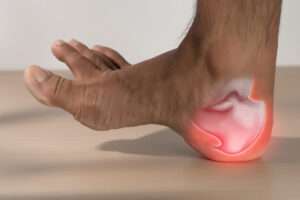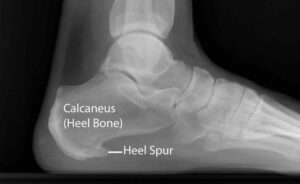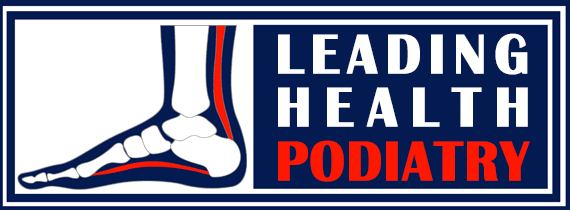Heel Spur
What is a Heel Spur?
A heel spur is a bony protrusion that develops on the bottom of the heel bone, often as a result of long-term damage or inflammation to the plantar fascia or Achilles tendon. These tendons attach to the heel bone, and when they experience ongoing stress, the body compensates by adding extra bone. The result is a heel spur, which typically faces the direction of the injured tissue. This is why heel spurs can form at both the bottom (plantar fascia) and the back (Achilles tendon) of the heel.

It’s important to note that heel pain is usually caused by damage to the tendons, not the heel spur itself. Treating the underlying tendon damage often resolves the pain without the need for surgery.
Who is Prone to Heel Spurs?
Anyone with prolonged plantar fasciitis or Achilles tendonitis (lasting 6-8 weeks) can develop a heel spur. However, some groups are more prone to heel spurs, including:
- Women: High-heeled shoes can shorten the Achilles tendon over time, increasing the risk of a heel spur.
- Older Adults: Natural wear and tear on the feet, along with thinner fat pads (Fat Pad Syndrome), can contribute to heel spurs.
- Active Individuals: People involved in sports or long-term physical activity, especially with ongoing heel pain, are at higher risk of developing heel spurs.
Symptoms of Heel Spurs
Not everyone with a heel spur will experience symptoms. However, when they do occur, the most common symptoms include:
- Sharp pain: Felt when standing or walking, especially on hard surfaces.
- Dull ache: Persistent pain at the heel, which may worsen over time.
- Visible bump: A tender, small protrusion under the heel that makes walking barefoot uncomfortable.
An X-ray is the most reliable way to confirm the presence of a heel spur.

Heel Spur Treatment
To effectively treat heel pain, it’s crucial to address the underlying cause, such as plantar fasciitis or Achilles tendonitis. Our podiatrists at Leading Health Podiatry will assess your condition and provide a tailored treatment plan, which may include:
- Custom Orthotics: Corrective insoles designed to support the foot and manage issues like overpronation or supination.
- Stretching Exercises: Targeted stretches for the plantar fascia and Achilles tendon to reduce tightness and discomfort.
- Proper Footwear: Shoes that offer support and reduce strain on the tendons.
- Shockwave Therapy: A non-invasive treatment option that uses high-energy sound waves to stimulate healing in damaged tissues. Shockwave therapy helps reduce inflammation, improve circulation, and promote tissue regeneration in the heel area.
- Physical Therapy: Exercises that strengthen the muscles of the feet and lower legs to enhance flexibility.
If conservative treatments do not relieve symptoms, surgery to remove the heel spur may be considered as a last resort.
Helpful Heel Spur Exercises
Simple stretching exercises can help reduce pain and inflammation associated with heel spurs:
- Toe stretches: While sitting, gently pull your toes back toward your shin to stretch the plantar fascia.
- Golf ball massage: Roll a golf ball underneath your foot to loosen up the fascia and alleviate tightness.
These exercises can help manage pain and improve flexibility in the affected area.
FAQs About Heel Spurs
How do I get rid of heel spurs?
The key to resolving heel pain is treating the underlying cause, such as plantar fasciitis or Achilles tendonitis. Once the tendon damage is addressed, heel pain often subsides. Surgery to remove the heel spur may be necessary in rare cases but is usually not required.Can heel spurs cause back pain?
Heel spurs themselves do not directly cause back pain. However, issues with foot alignment may affect posture and lead to back discomfort.Are heel spurs hereditary?
Heel spurs are generally not hereditary. They are caused by repetitive stress and damage to the foot’s tendons and muscles.
Heel Spur Treatment at Leading Health Podiatry
If you’re experiencing heel pain or suspect a heel spur, our podiatrists at Leading Health Podiatry can help. We offer comprehensive assessments and customised treatment plans designed to relieve pain and prevent future issues. Contact us today to book your appointment and take the first step toward pain-free feet.
